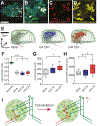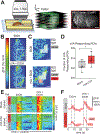Circuit reorganization in the Drosophila mushroom body calyx accompanies memory consolidation
- PMID: 33730583
- PMCID: PMC8515896
- DOI: 10.1016/j.celrep.2021.108871
Circuit reorganization in the Drosophila mushroom body calyx accompanies memory consolidation
Abstract
The formation and consolidation of memories are complex phenomena involving synaptic plasticity, microcircuit reorganization, and the formation of multiple representations within distinct circuits. To gain insight into the structural aspects of memory consolidation, we focus on the calyx of the Drosophila mushroom body. In this essential center, essential for olfactory learning, second- and third-order neurons connect through large synaptic microglomeruli, which we dissect at the electron microscopy level. Focusing on microglomeruli that respond to a specific odor, we reveal that appetitive long-term memory results in increased numbers of precisely those functional microglomeruli responding to the conditioned odor. Hindering memory consolidation by non-coincident presentation of odor and reward, by blocking protein synthesis, or by including memory mutants suppress these structural changes, revealing their tight correlation with the process of memory consolidation. Thus, olfactory long-term memory is associated with input-specific structural modifications in a high-order center of the fly brain.
Keywords: Drosophila; Kenyon cell; functional imaging; functional plasticity; memory consolidation; microglomerulus; mushroom body; mushroom body calyx; projection neuron; structural plasticity.
Copyright © 2021 The Authors. Published by Elsevier Inc. All rights reserved.
Conflict of interest statement
Declaration of interests The authors declare no competing interests.
Figures




Similar articles
-
Synaptic organization in the adult Drosophila mushroom body calyx.J Comp Neurol. 2009 Dec 20;517(6):808-24. doi: 10.1002/cne.22184. J Comp Neurol. 2009. PMID: 19844895
-
The neural circuit linking mushroom body parallel circuits induces memory consolidation in Drosophila.Proc Natl Acad Sci U S A. 2019 Aug 6;116(32):16080-16085. doi: 10.1073/pnas.1901292116. Epub 2019 Jul 23. Proc Natl Acad Sci U S A. 2019. PMID: 31337675 Free PMC article.
-
Structural long-term changes at mushroom body input synapses.Curr Biol. 2010 Nov 9;20(21):1938-44. doi: 10.1016/j.cub.2010.09.060. Epub 2010 Oct 14. Curr Biol. 2010. PMID: 20951043
-
Olfactory learning skews mushroom body output pathways to steer behavioral choice in Drosophila.Curr Opin Neurobiol. 2015 Dec;35:178-84. doi: 10.1016/j.conb.2015.10.002. Epub 2015 Nov 3. Curr Opin Neurobiol. 2015. PMID: 26496148 Free PMC article. Review.
-
Functional neuroanatomy of Drosophila olfactory memory formation.Learn Mem. 2014 Sep 15;21(10):519-26. doi: 10.1101/lm.034363.114. Print 2014 Oct. Learn Mem. 2014. PMID: 25225297 Free PMC article. Review.
Cited by
-
Classifying Drosophila olfactory projection neuron boutons by quantitative analysis of electron microscopic reconstruction.iScience. 2022 Apr 1;25(5):104180. doi: 10.1016/j.isci.2022.104180. eCollection 2022 May 20. iScience. 2022. PMID: 35494235 Free PMC article.
-
Untangling the wires: development of sparse, distributed connectivity in the mushroom body calyx.Cell Tissue Res. 2021 Jan;383(1):91-112. doi: 10.1007/s00441-020-03386-4. Epub 2021 Jan 6. Cell Tissue Res. 2021. PMID: 33404837 Free PMC article. Review.
-
A neurotrophin functioning with a Toll regulates structural plasticity in a dopaminergic circuit.Elife. 2024 Dec 20;13:RP102222. doi: 10.7554/eLife.102222. Elife. 2024. PMID: 39704728 Free PMC article.
-
Structured sampling of olfactory input by the fly mushroom body.Curr Biol. 2022 Aug 8;32(15):3334-3349.e6. doi: 10.1016/j.cub.2022.06.031. Epub 2022 Jul 6. Curr Biol. 2022. PMID: 35797998 Free PMC article.
-
Genetic regulation of central synapse formation and organization in Drosophila melanogaster.Genetics. 2022 Jul 4;221(3):iyac078. doi: 10.1093/genetics/iyac078. Genetics. 2022. PMID: 35652253 Free PMC article. Review.
References
Publication types
MeSH terms
Substances
Grants and funding
LinkOut - more resources
Full Text Sources
Other Literature Sources
Molecular Biology Databases

